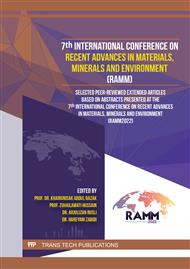[1]
Chan NW, Managing Urban Rivers and Water Quality in Malaysia for Sustainable Water Resources. Int J Water Resour Dev 28 (2012): 343–354
DOI: 10.1080/07900627.2012.668643
Google Scholar
[2]
Lee KE, Mokhtar M, Mohd Hanafiah M, Abdul Halim A, Badusah J, Rainwater harvesting as an alternative water resource in Malaysia: Potential, policies and development. J Clean Prod 126 (2016):218–222
DOI: 10.1016/j.jclepro.2016.03.060
Google Scholar
[3]
Khong LX, Ismail S, Saad NA, Kamaruddin MA, Nizar NHA, Zabidi H, Evaluation on groundwater quality of limestone aquifer in Kinta Valley, Perak for the use as irrigation water. Mater Today Proc 66 (2022):3040–3043
DOI: 10.1016/J.MATPR.2022.07.334
Google Scholar
[4]
Zabidi H, Termizi M, Aliman S, Ariffin KS, Khalil NL, Geological Structure and Geomorphological Aspects in Karstified Susceptibility Mapping of Limestone Formations. Procedia Chem 19 (2016):659–665
DOI: 10.1016/J.PROCHE.2016.03.067
Google Scholar
[5]
Waltham AC, Fookes PG, Engineering classification of karst ground conditions. Q J Eng Geol Hydrogeol 36 (2003):101–118
DOI: 10.1144/1470-9236/2002-33
Google Scholar
[6]
Veress M, Karst types and their karstification. J Earth Sci 31 (2020):621–634
DOI: 10.1007/s12583-020-1306-x
Google Scholar
[7]
Anua NEQM, Zabidi H, Petrography and Geochemistry of Kinta Valley Palaeozoic Carbonate Rock. J Phys Conf Ser 1082:012095 (2018)
DOI: 10.1088/1742-6596/1082/1/012095
Google Scholar
[8]
Veress M, A General Description of Karst Types. Encyclopedia 2 (2022):1103–1118
DOI: 10.3390/encyclopedia2020073
Google Scholar
[9]
Yassin RR, Muhammad RF, Taib SH, Al-Kouri O, Application of ERT and Aerial Photographs Techniques to Identify the Consequences of Sinkholes Hazards in Constructing Housing Complexes Sites over Karstic Carbonate Bedrock in Perak, Peninsular Malaysia. J Geogr Geol 6 (2014):55–89
DOI: 10.5539/jgg.v6n3p55
Google Scholar
[10]
Peng LC, Leman MS, Karim R, Peng LC, Stratigraphy lexicon of Malaysia. Geological Society of Malaysia, Kuala Lumpur, Malaysia (2004).
Google Scholar
[11]
Bhatnagar A, Hogland W, Marques M, Sillanpää M, An overview of the modification methods of activated carbon for its water treatment applications. Chem Eng J 219 (2013):499–511
DOI: 10.1016/J.CEJ.2012.12.038
Google Scholar
[12]
Hashim MA, Mukhopadhyay S, Sahu JN, Sengupta B, Remediation technologies for heavy metal contaminated groundwater. J Environ Manage 92 (2011):2355–2388
DOI: 10.1016/J.JENVMAN.2011.06.009
Google Scholar
[13]
EPA, National Primary Drinking Water Regulations | US EPA. In: Epa.gov United States Environ. Prot. Agency (2020). https://www.epa.gov/ground-water-and-drinking-water/national-primary-drinking-water-regulations. Accessed 6 Jan (2023)
DOI: 10.2172/10176450
Google Scholar
[14]
MOH, Drinking Water Quality Standard (2016). https://environment.com.my/wp-content/uploads/2016/05/Drinking-Water-MOH.pdf
Google Scholar
[15]
Piper AM, A graphic procedure in the geochemical interpretation of water‐analyses. Eos, Trans Am Geophys Union 25(1944):914–928
DOI: 10.1029/TR025I006P00914
Google Scholar
[16]
Gibbs RJ (1970) Mechanisms controlling world water chemistry. Science 170:1088–1090
DOI: 10.1126/SCIENCE.170.3962.1088
Google Scholar
[17]
He X, Wu J, He S (2019) Hydrochemical characteristics and quality evaluation of groundwater in terms of health risks in Luohe aquifer in Wuqi County of the Chinese Loess Plateau, northwest China. Hum Ecol Risk Assess 25:32–51
DOI: 10.1080/10807039.2018.1531693
Google Scholar
[18]
Sharma CM, Kang S, Tripathee L, Paudyal R, Sillanpää M (2020) Major ions and irrigation water quality assessment of the Nepalese Himalayan rivers. Environ Dev Sustain 2020 232 23:2668–2680
DOI: 10.1007/S10668-020-00694-1
Google Scholar
[19]
Elsayed Gabr M, Soussa H, Fattouh E (2021) Groundwater quality evaluation for drinking and irrigation uses in Dayrout city Upper Egypt. Ain Shams Eng J 12:327–340
DOI: 10.1016/j.asej.2020.05.010
Google Scholar



